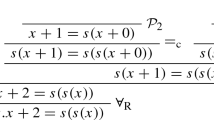Abstract
The concept of well-behaved inference rules is developed in first-order polynomial-based theorem proving. It is shown that well-behaved inference rules are complete for both the set of support strategy and the linear strategy. Furthermore, two concrete inference rules that are well behaved are presented, and two other strategies for them are described.
Similar content being viewed by others
References
Chang, C.-L. and Lee, R. C.: Symbolic Logic and Mechanical Theorem Proving, Academic Press, New York, 1973.
Hsiang, J.: Topics in automated theorem proving and program generation, Ph.D. Thesis, University of Illinois at Urbana-Champaign, UIUCDCS-R-82-1113, 1982.
Hsiang, J.: Refutational theorem proving using term-rewriting systems, Artif. Intell. 25 (1985), 255–300.
Kapur, D., and Narendran, P.: An Equational Approach to Theorem Proving in First-Order Predicate Calculus, 84CRD322, GE Research Lab., 1985.
Knuth, D. E. and Bendix, P. B.: Simple word problems in universal algebras, in J. Leech (ed.), Computational Problems in Abstract Algebras, Pergamon Press, 1970, pp. 263–297.
Liu, X. H. and Sun, J. G.: Generalized resolution and NC-resolution, J. Comput. Sci. and Technol. 9(2) (1994), 160–167.
Loveland, D.: Automated Theorem Proving: A Logical Basis, North-Holland, New York, 1978.
Muller, J. and Socher-Ambrosius, R.: On the unnecessity of multiple overlaps in completion theorem proving, in Proc. 12th GWAI, IFB 181, 1988.
Murray, N. V.: Completely non-clausal theorem proving, Artif. Intell. 18(1) (1982), 67–85.
Wang, X. H. and Liu, X. H.: Generalized resolution, Chinese J. Computer 5(2) (1982), 81–92.
Wu, J. Z. and Liu, Z. J.: Linear strategy, semantic strategy and lock strategy in remainder method, accepted by Chinese J. Computer.
Wu, J. Z. and Liu, Z. J.: The remainder method for the first-order theorem proving, accepted by Chinese J. Computer.
Wos, L.: Automated Reasoning: 33 Basic Problems, Prentice-Hall, Englewood Cliffs, New Jersey, 1988.
Wu, W. T.: Basic principles of mechanical theorem proving in elementary geometries, J. Systems Sci. Math. Sci. 4 (1984), 207–235.
Zhang, H.: A new method for the Boolean ring based theorem proving, J. Symbolic Comput. 17 (1994), 189–211.
Author information
Authors and Affiliations
Rights and permissions
About this article
Cite this article
Wu, J., Liu, Z. Well-Behaved Inference Rules for First-Order Theorem Proving. Journal of Automated Reasoning 21, 381–400 (1998). https://doi.org/10.1023/A:1006027228476
Issue Date:
DOI: https://doi.org/10.1023/A:1006027228476




